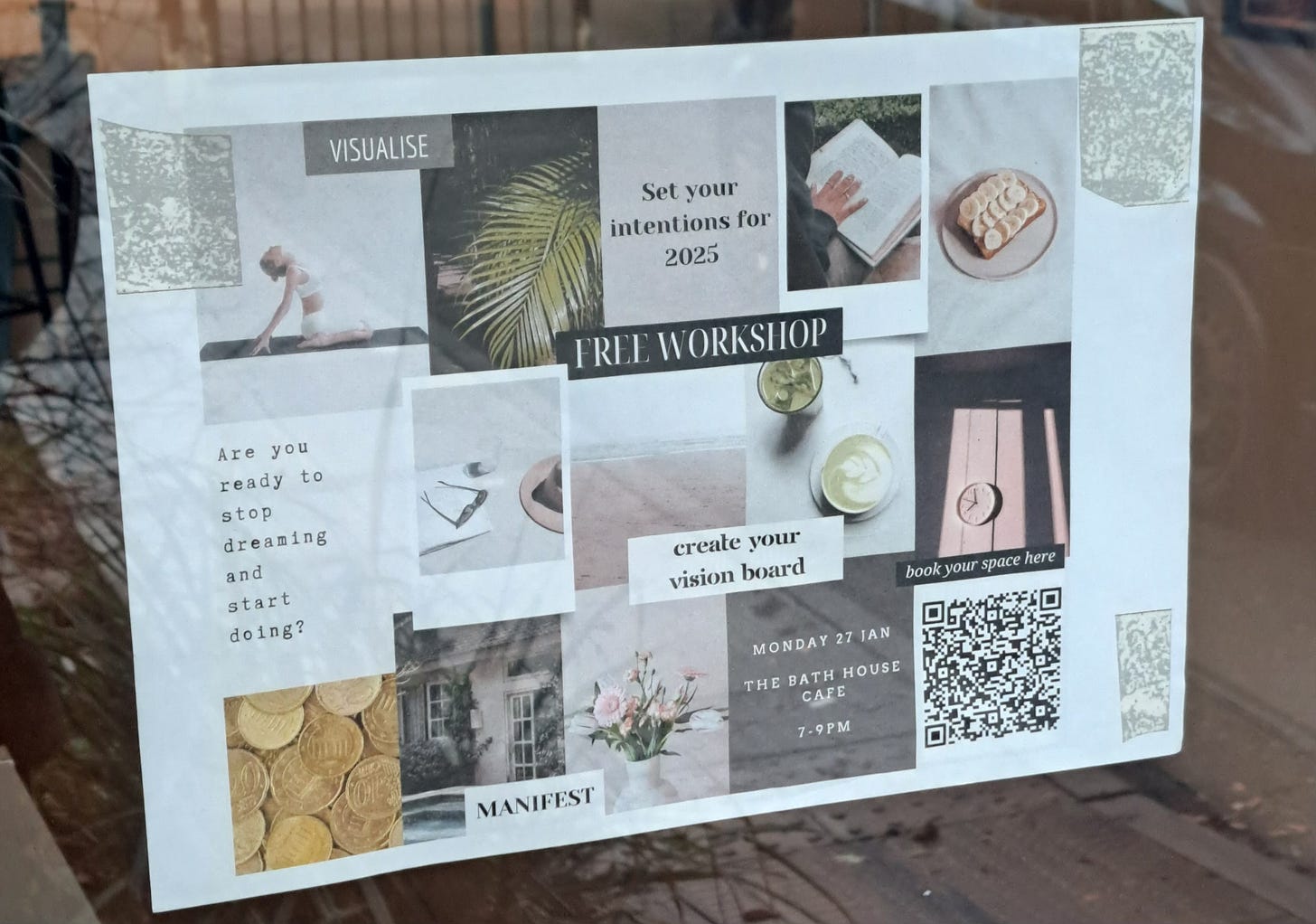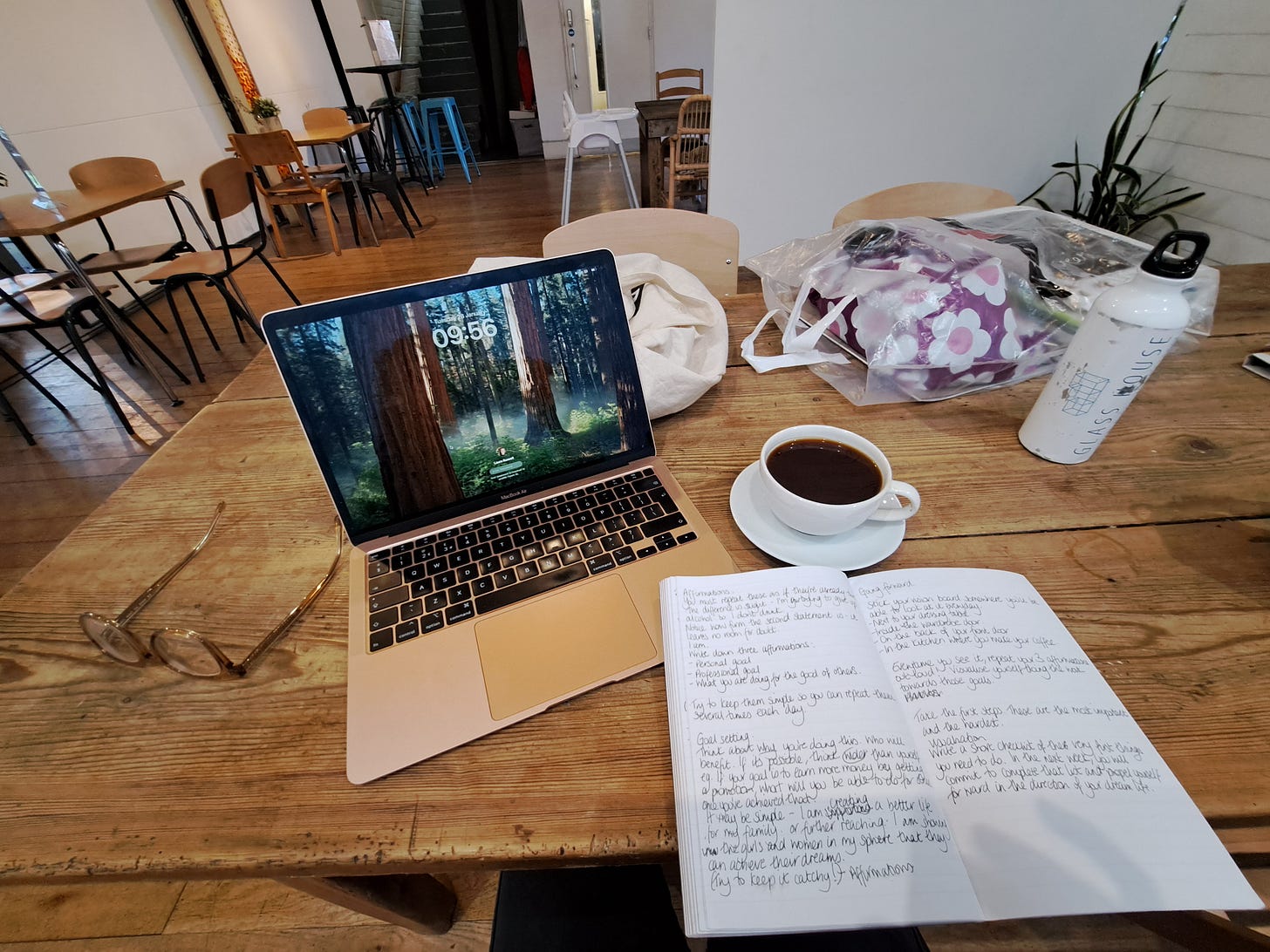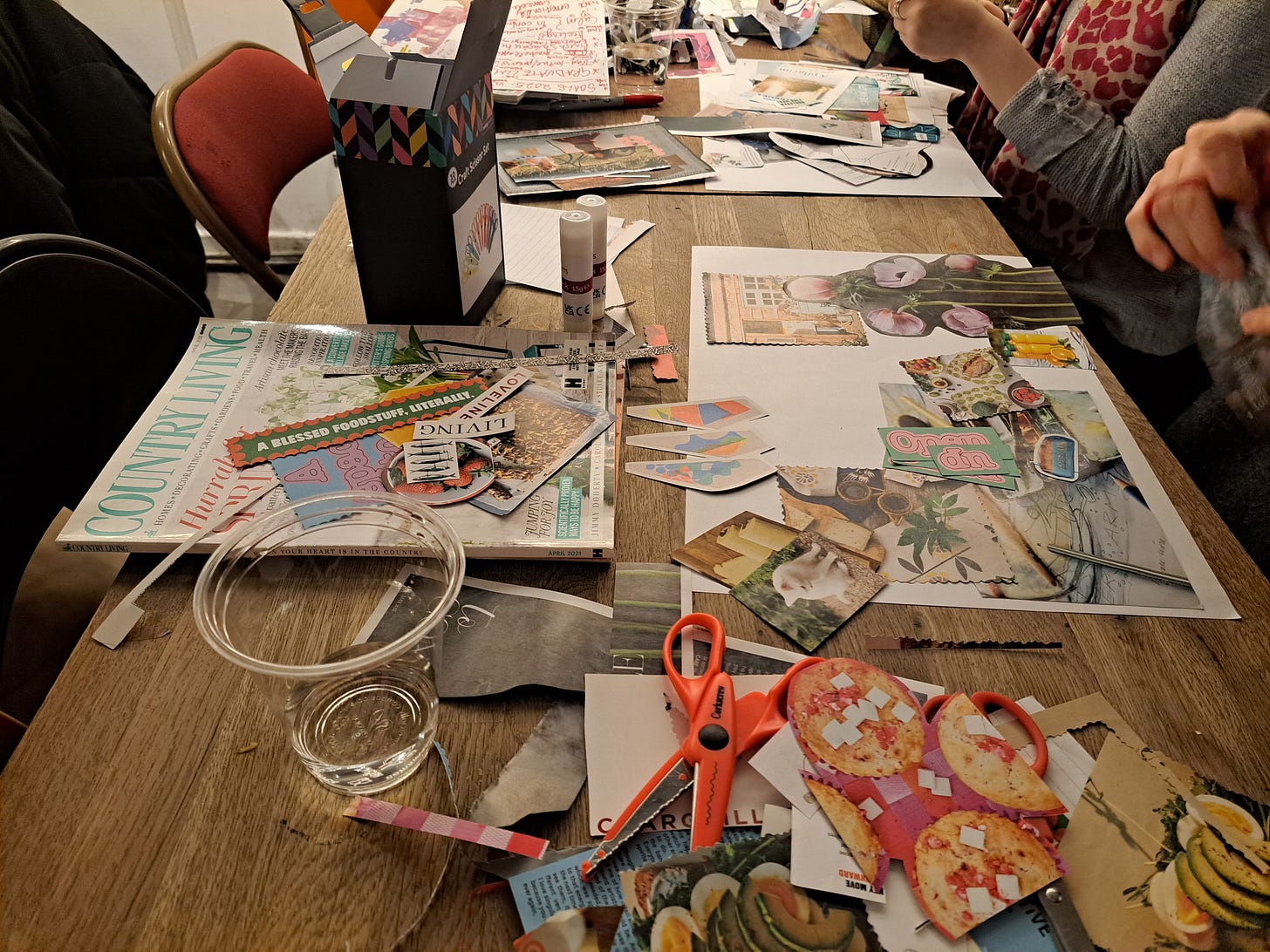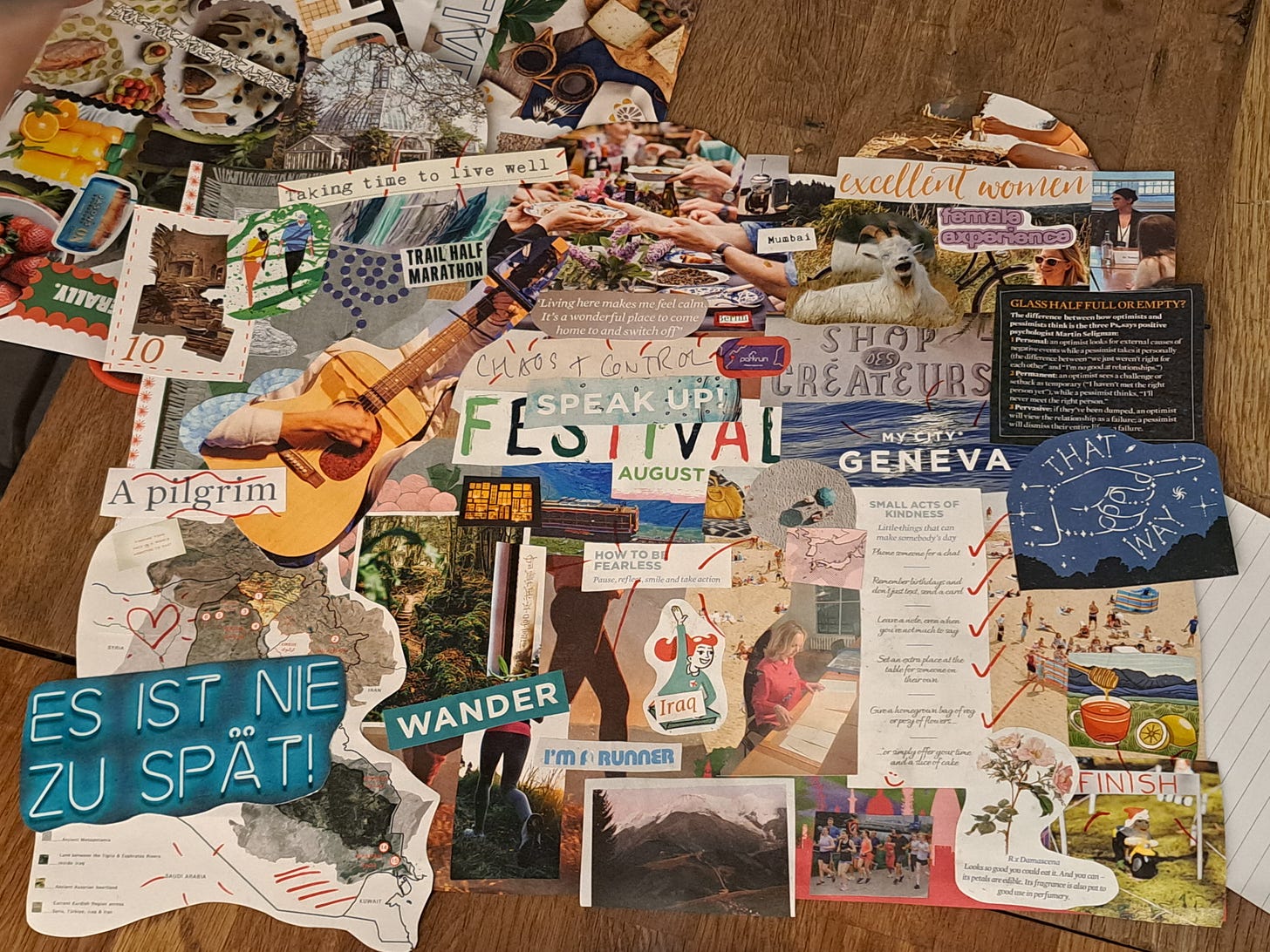Laura has a vision(board)
January is the perfect time for setting goals and visualising them becoming reality. Here's how I do it.
A long time ago, I made a vision board and put it in a frame on my bedroom wall. I didn’t realise at the time that it was a vision board - it was just some photos of me and my friends, along with some sweet images and messages I’d cut from birthday cards and pasted together in a collage.
Whenever I looked at it, I felt loved and supported at a time when I really needed that sense of community and acceptance. The more I looked at it, the more I believed in myself as a person who deserved those things and who was loved.
Whilst on a training run in early January, I listened to a podcast about setting goals, visualisation and manifestation.
I had a brainwave - what if I ran a workshop to help other people set their goals and create their vision boards?
Not one to let the grass grow under my feet, by the next day I’d booked the space at my local cafe, and the day after that I had tickets on eventbrite.
Fast forward to the start of this week. On a rainy Monday evening, right before January payday, I welcomed 10 workshop attendees ready to get clear about their goals and take home their own vision boards.
Let me take you through the steps.
Identify your goals
Take some time to write down all of the things you’d love to achieve and here’s the important bit - WHY you want to achieve them.
Think about what it means to you and how it could also benefit others. The reason for this is that when your achievement is likely to have a positive impact on others, you’ll feel extra motivation to achieve it.
Be specific. “Get healthier” is vague and there’s no way to measure whether you’ve done it. If getting healthy to you means to cook at home and stop ordering takeaway, then make a specific goal to only order in once a month. If it’s to learn to swim, the goal could be to complete 1000m front crawl/freestyle in your weekly session.
Looking at your list of goals, choose two that feel the most urgent to you. Let’s say one personal goal and one professional.
Write a story about each of those goals in the past tense. As if it’s already done and you’re telling someone how you did it. Tell them what the specific goal was, what the challenges were and how you overcame them. Tell them how you measured your progress as the months went by and what the benefits have been to the people around you.
Affirmations
Let’s look at your goals again and practice saying them with short and simple “I am” statements. Not “I’ll try to” or even “I will be”. I AM. The language is only very slightly different, but the difference in intention is huge.
Write three statements; one each for your personal and professional goals, and one stating the benefit to others. Here’s an example;
I AM a competent swimmer
I AM a leader in my industry
I AM inspiring female graduates at my firm
These statements are your affirmations. They should be short and simple enough to remember and repeat whenever you look at your finished vision board.
Repeating your affirmations will boost your positive feelings about the goals you’ve set for yourself and your ability to achieve them.
Visualisation
The exercise of writing out your goals in part 1 is to help you visualise the process. It’s important not only to imaging reaching your goals, but to see yourself going on the journey you’ll take to get there.
Think about where you need to grow. What skills you will need to learn or develop. Will you need a coach, teacher or mentor?
Write a short checklist of the very first things you’ll need to do. Here’s an example.
If your goal is to learn to swim, you will have to find a teacher, book the lessons, go to the lessons. You may need a membership to access the pool. Think about what equipment or resources you need to collect and put those on the checklist. A swimsuit and goggles and a bag to carry your wet things home.
By writing down these steps, you start to imagine yourself doing the work and becoming the person who goes to the pool. This is very powerful way to ‘become’.
Creating your vision board
Now you have your goals set, you’ve thought about the journey and visualised yourself making the changes you need to achieve, it’s time to start creating your vision board.
Collect some magazines, greetings cards, photographs and whatever you have to hand that you don’t mind cutting up. You’ll need scissors, glue and a big piece of paper or card (a cardboard box could also be cut to size for this. A3 is about the right size.
Spend some time looking at the images and without trying to be too specific, cut or tear out any images that you feel represent how you’ll feel achieving your goals for the year. On my own board, I chose a picture of a rollercoaster. Not because I expect the year to have ups and downs, but to remind me to have fun and enjoy the journey.
It’s ok to have white space if you choose, you can also decide to cover the whole board with colours, patterns, landscapes, words and phrases - whatever makes a board you like the look of.
Once you’re happy that your images represent the goals you want to achieve, and you’ve laid them out in a pleasing arrangement, it’s time to stick them down.
Manifestation
Manifesting IS NOT wishing, hoping, praying or dreaming about what we want. Manifesting IS strategising, planning, plotting and doing. To manifest something is to make it happen. You will not learn to swim sitting at home watching videos of other people swimming*.
Look at the checklist you made earlier for your first steps. That is your to-do list for the first week.
Once you’ve checked those things off the list, you should start to have a clear understanding of the next things you need to do. Take yourself back to visualisation mode and write down those next steps. Now you have a new checklist for the second stage. And so on.
(*By all means, please do watch videos of other people swimming for motivation and tips on technique once you’ve actually started swimming.)
Using your vision board
Your vision board is a tool that will help remind you of the reality you’re manifesting by achieving the goals you’ve set for yourself. When you look at your vision board, you can conjure those feelings by repeating your affirmations.
Put your vision board somewhere in your home where you’ll be able to look at it every day. I suggest where you get ready in the morning, where you make your coffee (or tea), or by your desk if you work from home - or feel empowered to put it up in your office and talk to your colleagues about it!
Every time you look at your vision board, remember your three affirmations and repeat them aloud.
Visualise yourself doing the tasks on your checklist and becoming the person who achieves those goals.
Check in with yourself at regular intervals (you decide those depending on your goals) Are you progressing in the way you envisioned? Do you need to do an extra piece of work or learning that you hadn’t anticipated? What might you need to change in other areas of your life to help you achieve your goals?
One last thing to remember.
If you suffer a set back, that doesn’t mean ‘give up and go home’. A set back is simply a diversion that tells us we need to adjust the route.
We can make a detour, get back on track and continue to move forward confidently in the direction of our dreams.
If you’re looking for a professional workshop facilitator to run a goal setting, vision boarding or any other type of workshop for your organisation, please feel welcome to message me here.







